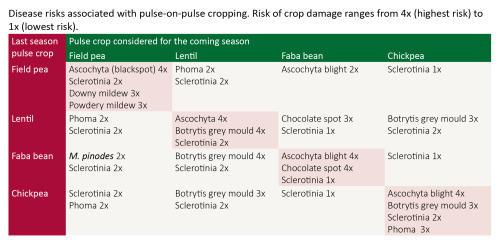In years where the seasonal conditions result in poor growth, and where many crops fail, it is very tempting to re-sow paddocks to the same or another pulse crop in the following year. However, there are several disease management issues growers should be aware of before deciding to take this course of action.
Pulse options after a failed pulse crop
Sowing pulses on pulses increases the risk of crop failure in seasons favourable for disease development. Many pathogens that cause common diseases in pulse crops can survive quite well in dry years. Stubble residues can harbour several foliar diseases, including:
- Ascochyta and Phoma pathogens of chickpea, lentil, field pea and faba bean
- Botrytis pathogens such as grey mould of lentil and chickpea, and chocolate spot of faba bean.
Some pathogens that cause several common diseases can also survive in the soil in the absence of stubble residue, including:
- Phoma medicaginis, which causes phoma stem blight in both field pea and chickpea
- Perenospora viciae, which causes downy mildew of field pea
- Botrytis fabae, which causes chocolate spot in faba bean and grey mould in lentil
- Sclerotinia sclerotiorium, which causes sclerotinia in pulses.
Root rot pathogens such as Phytophthora and Pythium can also survive under dry conditions but are strongly dependent on soil moisture to become active. Generally, these pathogens are always present in the soil at low levels and cause damage to plants under very wet conditions.
Sowing a pulse crop into the same paddock as a failed pulse crop from the previous year could expose the new crop to potentially high levels of inoculum. This practice is in contrast to the crop rotation principle where non-host crops are grown for two to three years before sowing another pulse so that inoculum levels in the field can decrease to safer levels. The risk of high disease pressure in the following pulse crop will be largely dependent on the pulse crop sown, the prevailing weather conditions (generally the more moisture present, the higher the disease risk) and the initial inoculum level.
However, through careful assessment of the risk it can be possible to sow another pulse after a failed pulse crop with reduced risk of losses to disease. The following table presents the most important diseases for each pulse crop and the threat each disease can pose to the following pulse crop.
 Recommendations
Recommendations
To avoid damage by disease in the following pulse crop, consider implementing these recommendations:
- Do not sow the same pulse crop species in the same paddock. From the table above it is clear that planting the same pulse species represents the greatest disease risk. Even if the season has been dry, sufficient levels of inoculum can survive and quickly reproduce early in the new season, putting pressure on the young plants.
- Consider planting a non-pulse, non-host crop or select a pulse crop that poses the lowest disease risk.
- Use a fungicidal seed dressing. This will protect the new crop from early infection by root rot pathogens and allow healthy seedling establishment.
- Where possible, graze or burn stubble residue before sowing. Do this late in the season so as not to leave the soil surface exposed to erosion over summer. Removal of stubble residue prior to sowing will reduce inoculum levels for the following pulse crop.
- Be aware of self-sown plants that could emerge in the following pulse crop. Dun-type field peas have a degree of hard seed and lentils are often a problem due to the large numbers of small seed. Self-sown plants can act as a source of inoculum in the following pulse crop. These plants can also contaminate seed if allowed to grow through to maturity. Growers should be aware of the difficultly of grading out some pulse seeds and possible downgrading of seed due to contamination.
- Do not be tempted to let self-sown plants establish as a substitute crop because this represents a high disease risk situation. Self-sown plants often emerge early and in large numbers, creating a perfect environment for disease establishment. Self-sown crops are highly likely to fail by the end of winter due to high disease pressure.
 Original authors are acknowledged: Trevor Bretag and Kurt Lindbeck, DPI – Horsham
Original authors are acknowledged: Trevor Bretag and Kurt Lindbeck, DPI – Horsham
For more information on pulse crop production: pulseaus.com.au/growing-pulses/bmp/
Contact Pulse Australia

